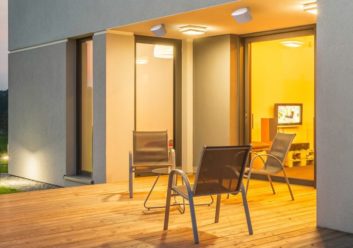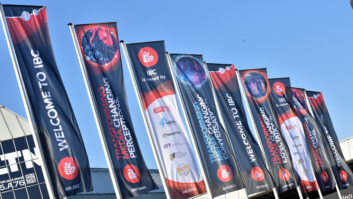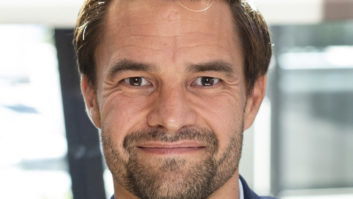The pandemic has profoundly changed the way many of us think about how we live and work. Health, safety and sustainability – powerful concepts reflected at the Smart Building Conference at ISE 2022 – are driving the global smart building market toward $265.37 billion (https://www.fortunebusinessinsights.com/industry-reports/smart-building-market-101198) by 2028. Thanks to the combination of smart sensor technology and the expertise of integrators, homeowners and building managers can create smart systems enabling their buildings to be increasingly intuitive, adaptable and responsive.
In the home, specific devices like surveillance cameras and smart light bulbs are contributing to spend on smart home solutions exceeding $100 billion by the end of 2021, according to Strategy Analytics.
 “Consumer demand for connected systems and services in the home is increasing by the day and has been accelerating as a result of the global pandemic,” says Matt Nimmons, MD, CEDIA EMEA. “In the past eighteen months, we’ve witnessed a real expansion in the trend for technologies to facilitate working from home, or as some are calling it, living at work. Many CEDIA members have worked with developers on delivering robust and secure wi-fi connected spaces that can serve as the home office, complete with the high-quality audio and video performance to match.”
“Consumer demand for connected systems and services in the home is increasing by the day and has been accelerating as a result of the global pandemic,” says Matt Nimmons, MD, CEDIA EMEA. “In the past eighteen months, we’ve witnessed a real expansion in the trend for technologies to facilitate working from home, or as some are calling it, living at work. Many CEDIA members have worked with developers on delivering robust and secure wi-fi connected spaces that can serve as the home office, complete with the high-quality audio and video performance to match.”
MULTI-FUNCTIONAL
As such, the home is now a multi-functional space that provides a place of comfort, rest and relaxation as well as a secure and practical home office, a learning environment, a cinema, gaming room and fitness suite.
“The biggest developments are not so much in new smart tech, but more in the deployment of it,” says Stuart Tickle, MD at custom integration distribution company, AWE. “Now that people are spending more time at home, things previously thought of as luxury have become more standard.”
He cites smart security cameras to keep an eye on kids playing in the garden, and convenient control of energy efficient lighting and heating. Lighting control systems integrated into the wider home automation system can bring other benefits in terms of ease of use, ‘scene’ setting and even deliver human centric lighting.
“There are no signs of this trend stopping with growth looking set to continue throughout 2022,” he adds. “We are in a rare time when supply is outstripping demand, so integrators have long pipelines of work scheduled in too.”
In turn, this demand has driven investment “in the technology that can deliver the services, comfort and convenience that people now see they need,” advises Peter Broome, Director at UK smart lighting controls manufacturer Rako. “Homeowners have turned to integrators to help make the technology experience as easy to use, reliable and enjoyable as possible.”
HEALTH & WELLNESS
Health and wellness remain in sharp focus as we approach the end of 2021. Whether through lights that sync to a home-owner’s circadian rhythm to help them sleep better or proper air filtration that offers relief for their allergies, ‘Well-tech’ is creating new ways for people to achieve their desired health outcomes.
“Well-tech is one of the fastest growing technology trends in the residential market, and integrators are the best equipped to implement these products into the home,” says CEDIA senior director strategic partnerships, Ian Bryant. “Well-tech fits right into the consultative model embraced by many in the CI industry, as they pivot from ‘selling tech’ to improving and enhancing customers’ lives in their homes.”
Giles Sutton, CEDIA interim CEO, even calls these technology solutions “truly lifechanging… and they are no long reserved for early adopters or the ultra-wealthy.”
 There are calls for integrators to develop their relationships with related trades – lighting designers, HVAC installers, plumbers – in order to become the ‘general contractor’ or coordinator of a holistic wellness solution.
There are calls for integrators to develop their relationships with related trades – lighting designers, HVAC installers, plumbers – in order to become the ‘general contractor’ or coordinator of a holistic wellness solution.
Walt Zerbe, senior director of technology & standards, CEDIA explains, “Integrators need to spend more time on the discovery side to really understand what the customer’s needs are – who the family members are, what each of them require, is anyone working or learning from home – and it takes an increased amount of study to prescribe a wellness solution for each customer. It’s very personalised. There’s no doubt that wellness is a giant opportunity for integrators to capitalise on.”
MEDIA MANAGEMENT
The increased time people spent watching TV and online video in 2020 has resulted in an uptick in demand for dedicated cinemas or media rooms with bigger screens and powered up audio. Similarly, our collective home time is generating demand for cabling that enable outdoor lighting and entertainment systems, in turn helping people to be sociable with garden spaces for wellness and mental health.
The convenience and sanitary nature of voice control is further driving demand for smart appliances. “In particular the growth of dedicated control systems that bring all these devices together and make it easy for customers to navigate and operate via a single platform across multiple control methods, automated, voice and button,” says Tickle.
In this context, remote monitoring and management (RMM) has become more critical for integrators than ever. RMM is one of the key industry evolutions in recent times and, increasingly, becoming a necessity for today’s smart home installation business, says Mark Reynolds, senior director, EMEA, Snap One.
To put this into context, remote management platform OvrC by Snap One currently has over 1.5 million devices registered at around 350,000 locations with 15,000+ dealers.
 “The ability to access the right tools (Control, Notifications and Monitoring) and having these fundamental resources available in the convenience of one location only enhances the pre and post installation experience,” says Reynolds. Aside from saving the cost of a site visit, the ability to resolve tech issues remotely, often without even the need to visit the site, is a bonus during a pandemic. “Throughout the past eighteen months, more and more clients have understandably wanted to keep any intrusion from tradespeople into their homes to an absolute minimum,” he says.
“The ability to access the right tools (Control, Notifications and Monitoring) and having these fundamental resources available in the convenience of one location only enhances the pre and post installation experience,” says Reynolds. Aside from saving the cost of a site visit, the ability to resolve tech issues remotely, often without even the need to visit the site, is a bonus during a pandemic. “Throughout the past eighteen months, more and more clients have understandably wanted to keep any intrusion from tradespeople into their homes to an absolute minimum,” he says.
There’s an opportunity here for vendors and integrators who can pull together media management alongside the networking, audio, video cores. “With so many different content providers, most of us have issues in easily accessing what we want to watch content,” Zerbe says. “So, the next big wave is going to be getting someone in who can manage your media for you and make it simple to use.”
TECH FOR LIFE
The seismic shift for many organisations from on-site working to remote working was an enforced one, but the return to work is unlikely to be a simple reversal of this. Companies are instead looking at long-term ways they can use their buildings more intelligently.
“To battle meeting fatigue, more and more companies are providing dedicated meeting devices that can be used at the home office,” says Stijn Ooms, director product strategy AV and digital workplace at Crestron. “Businesses need to make sure that the IT department can track everything and is able to keep the products working and updated no matter what, or where. That can be done through the cloud.”
Frost & Sullivan reported that, before Covid-19, out of the nearly 90 million meeting rooms worldwide, only 7.8 percent are video-enabled. That is quickly changing: with hybrid work becoming more dominant. Adding video conferencing and collaboration technology to every space, large or small, is now a requirement.
 “If companies want to retain their workforce and keep them productive, it’s key to make them feel equal and connected whether they are at the office or working from home,” Ooms says. “The right technology, for instance intelligent video and audio, can help with that.”
“If companies want to retain their workforce and keep them productive, it’s key to make them feel equal and connected whether they are at the office or working from home,” Ooms says. “The right technology, for instance intelligent video and audio, can help with that.”
According to Gartner (https://www.gartner.co.uk/en/newsroom/press-releases/2020-10-29-gartner-survey-reveals-47-percent-of-organizations-will-increase-investments-in-iot-despite-the-impact-of-covid-19), 47% of businesses are planning to increase their investments in the Internet of Things (IoT). These organisations are using smart technology to optimise everything from occupancy to energy use, improving sustainability and wellbeing and ultimately reducing costs.
ISE TIME!
The Smart Building Conference (SBC) produced by ISE is the must-attend pan European conference for professionals working in the smart buildings industry. It is being held on 31 January, the day before ISE opens, at the Fira de Barcelona. Covering commercial, residential and office opportunities, SBC 2022 will explore how the unfolding new technology landscape facilitates the deployment of smart technology within buildings.
 On the show floor of ISE itself, visitors will find plenty to inspire them in the Residential and Smart Building Zone in Hall 2. They’ll find systems for designing lighting that responds to changes in ambient light levels during the day alongside the latest developments in connectivity standards, unified communications (UC) and technologies for improving the visual impact of loudspeakers and so much more.
On the show floor of ISE itself, visitors will find plenty to inspire them in the Residential and Smart Building Zone in Hall 2. They’ll find systems for designing lighting that responds to changes in ambient light levels during the day alongside the latest developments in connectivity standards, unified communications (UC) and technologies for improving the visual impact of loudspeakers and so much more.
Mike Blackman, Integrated Systems Events managing director explains: “As a physical, in-person event, we are in a unique place to bring all elements of the industry together under one roof and we cannot wait to see you all. In the build up to Barcelona we have worked hard to ensure that ISE 2022 offers a safe, enjoyable and very worthwhile experience for the industry to showcase innovation, be inspired by some of the brightest in the business. We look forward to seeing you there.” Integrated Systems Europe (ISE) 2022 will take place at the Fira de Barcelona, Gran Vía, on 1-4 February 2022.







